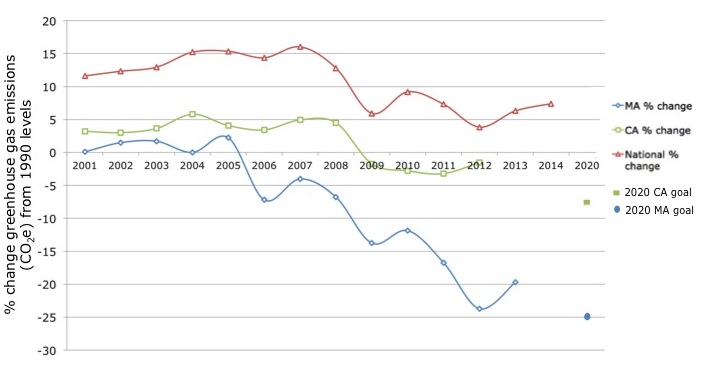
California and Massachusetts lead the country in climate action policies
Trump’s new EPA appointee is a states right champion. Well, California and Massachusetts have a lot to teach him about fighting climate change. These states have demonstrated the power of statewide climate policies in the past decade. Other states should take California and Massachusetts as models for statewide climate action.
California and Massachusetts have both taken action on climate change by passing statewide laws to reduce greenhouse gas emissions. The polices ensure that by 2020 California’s emissions will be 7% lower and Massachusetts’s emissions will be 25% lower, compared to their 1990 emissions. Their bills are effective approaches since they give each state a mandate to reduce greenhouse gases emissions. But at the same time the legislation offer flexibility to address various emitting sectors of the economy, like transportation and electricity production, through a combination of policies and incentives.
To help meet their respective goals, California and Massachusetts have implemented Renewable Portfolio Standards. These require utilities to increasingly source electricity with renewable energy. California’s renewable portfolio standard requires a third of the state’s electricity be sourced from renewable energy by 2020 while Massachusetts requires 15% by 2020. Under these policies, utilities have the flexibility in assembling a portfolio of renewable energy sources. The mandate ensures renewable energy infrastructure investment since the companies have a guaranteed market without having to compete with the potentially cheaper electricity sourced from fossil fuels.
Last year California and Massachusetts generated 26% and 10% of their electricity with renewable energy respectively. This puts both states on track to meet their 2020 renewable portfolio standards. In California, the dominant sources of renewable energy are wind, generating almost 10% of the state’s electricity, and solar, generating almost 6%. Massachusetts is a less populous state, so it uses less total electricity than California. The state also has lower renewable portfolio standards, however, its renewable energy generation is still impressive. The state relies more on hydropower, which comprises 3% of the state’s electricity while wind and solar comprise 4% combined and other renewables make up the remaining 3%.
In order to achieve their emission reduction goals, Massachusetts and California have also created innovative programs to promote energy efficiency and transportation emission reductions. Massachusetts has promoted energy efficiency in the state through building codes, audits for homeowners, and power plant efficiency standards. Massachusetts proudly ranks 1st in the nation for energy efficiency. These efforts have saved 980 gigawatt hours of electricity, equivalent to the average electricity use of 140,000 Massachusetts homes.
In addition to regulating greenhouse gas emission from automobiles, California has engaged cities in reducing transportation emissions through supplementary strategies. A state law requires the state’s major metropolises achieve their own emission reduction targets. Cities have approached these requirements, creating ridesharing incentives, electric vehicle programs, and enhanced bicycle and pedestrian paths. As individual cities implement these local, innovative programs, they contribute to achieving the state’s broader climate goals.
Some politicians say that renewable energy comes at the expense of jobs and economic growth, but California and Massachusetts serve as counter examples. The solar industry, for example, has grown rapidly in the last decade in both states, providing energy and jobs. California and Massachusetts rank first and second in number of jobs in the solar industry, with 75,000 jobs and15,000 jobs respectively.
In the next four years, states must look at California and Massachusetts as templates for statewide climate action policies. Even though these states differ in many ways, their climate action policies are strikingly similar. Both have mandated greenhouse gas emission reductions with specific timelines. These frameworks allow the states implement a combination of policies in order to achieve emission reductions. Then, renewable portfolio standards force utilities integrate renewable energy into the grid. Lastly, innovative programs target other emitting sectors of the economy.

Greenhouse gas emissions (CO2 equivalence) percent change from 1990 emissions for California, Massachusetts, and the United States nationally.
While national greenhouse gas emissions have stabilized, California and Massachusetts have driven their emissions down. Federal policy around climate change may be at a standstill or even regressive, but it is not the only way to enact climate action. Just look at the Golden State and the Bay State.